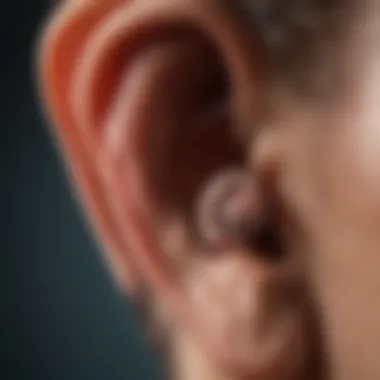Effective Head Movements for Managing Vertigo


Intro
Vertigo can be a challenging and debilitating experience. The world seems to spin, and the ground can feel as unsteady as a house of cards caught in a gust of wind. Many individuals grappling with this sensation often find themselves searching for remedies that might provide some relief. In this journey, exploring targeted head movements emerges as a potential pathway to alleviation. While medical treatments are integral, understanding how simple adjustments in head positions can influence vertigo symptoms opens a door to more accessible options.
Key Concepts and Terminology
Definition of Key Terms
Before diving into the remedies, it’s essential to clarify a few terms associated with vertigo and its treatment:
- Vertigo: A false sensation of movement, typically perceived as spinning or swaying. It may result from issues within the inner ear, brain, or sensory discrepancies.
- Vestibular System: This refers to the structures of the inner ear and brain that help control balance. It plays a crucial role in how we perceive our orientation in space.
- Benign Paroxysmal Positional Vertigo (BPPV): A common form of vertigo that occurs with specific head movements, often linked to tiny calcium crystals (otoconia) in the inner ear that become displaced.
- Epley Maneuver: A series of head movements that aim to reposition the displaced calcium crystals in individuals suffering from BPPV.
- Brandt-Daroff Exercises: A set of movements designed to help habituate the vestibular system to the changes that provoke vertigo.
Concepts Explored in the Article
The scope of this article revolves around a few key areas:
- Understanding the relationship between head movements and vertigo symptoms.
- Analyzing the efficacy of the Epley maneuver and Brandt-Daroff exercises.
- Exploring the physiological mechanisms that underpin these techniques.
- Emphasizing individualized approaches to treatment and their importance in managing vertigo.
Findings and Discussion
Main Findings
Extensive research indicates that specific head movements can help alleviate symptoms of vertigo, particularly in cases relating to BPPV. The Epley maneuver has gained traction in clinical settings, proving effective for many. Moreover, Brandt-Daroff exercises serve as a supplementary approach, encouraging adaptation in individuals who undergo frequent episodes of dizziness.
"Understanding how specific movements can reorient the internal structures of the ear not only empowers patients but also demystifies the condition itself."
Through examining various studies, it becomes evident that these head movements do more than just relieve symptoms; they tap into the underlying physiological interactions that govern how the brain interprets spatial orientation. It is particularly compelling to note that the effectiveness of these methods often varies from person to person, leading to the conclusion that a tailored approach is vital in managing symptoms.
Potential Areas for Future Research
While existing techniques offer promise, further research could illuminate deeper aspects of vertigo treatment:
- Investigating the long-term impacts of regular head movement exercises on individuals with chronic vertigo.
- Exploring the neural pathways involved when these movements are executed, thereby identifying new therapeutic strategies.
- Analyzing the effects of personalized treatment plans based on specific vestibular disorders, which could enhance overall efficacy.
These proposed research foci could provide new insights and lead to innovative ways to approach vertigo management, broadening the horizon of acceptable treatments and deepening our understanding of this complex condition.
Understanding Vertigo
Understanding vertigo is fundamental to address the complexities of this condition effectively. It isn’t merely a fancy word for dizziness; it’s a profound sensation of movement, often making individuals feel as though their surroundings are spinning. This phenomenon can be disorienting and can interfere significantly with day-to-day life. The more one comprehends vertigo—its nuances, symptoms, and underlying causes—the easier it becomes to explore potential remedies, including the specific head movements that may alleviate symptoms.
The importance of delving into vertigo is clear when considering the implications it has for personal well-being. People grappling with this condition often feel isolated, lost in a world that seems to sway beneath them. Understanding vertigo facilitates better communication with healthcare providers, empowering patients to express their concerns and seek out effective treatments. Moreover, it aids in educating friends and family about the experience of living with vertigo, fostering support and empathy.
In this section, we will explore the definition and symptoms of vertigo, identify common causes, and distinguish vertigo from other types of dizziness. By unraveling these elements, we aim to set the stage for discussing specific remedies, including head movements that might offer relief.
Definition and Symptoms
Vertigo is often characterized as a false sensation of movement. Those experiencing it may describe feelings as if they or their environment are spinning or tilting. This condition can manifest in various ways, including:
- Spinning sensation: The most common description, where one feels as if they are whirling like a top.
- Swaying or tilting: Patients might feel as though they are rocking back and forth or leaning to one side.
- Nausea: Discomfort in the stomach often accompanies the other symptoms.
- Loss of balance: An unsteady feeling can lead to a struggle with coordination.
The experience varies from person to person, and symptoms may last seconds or extend over several days. Such variations highlight the complexity of vertigo and the necessity for tailored treatment approaches.
Common Causes of Vertigo
Various factors can provoke vertigo, each underpinning the sensation and contributing to discomfort. Here are some significant causes:
Inner Ear Disorders
Inner ear disorders are among the primary culprits behind vertigo. The inner ear houses structures crucial for balance, and any disruption can send conflicting signals to the brain. Conditions such as benign paroxysmal positional vertigo (BPPV) often originate from tiny calcium crystals mistakenly entering the canals of the inner ear, creating misleading sensations of motion. A key characteristic of inner ear disorders is their sudden onset, often triggered by specific head movements, which renders them a relevant focus for understanding vertigo.
- Key characteristic: Sudden dizziness accompanied by changes in head position.
- Advantages: Targeted treatment methods, like the Epley maneuver, often yield success in alleviating symptoms.
- Disadvantages: While manageable, repeated episodes can lead to chronic discomfort or anxiety in affected individuals.
Vestibular Neuritis
Vestibular neuritis is another entity responsible for vertigo, stemming from inflammation of the vestibular nerve, usually following a viral infection. Individuals may experience intense, prolonged vertigo, often alongside nausea and balance issues. Its sudden appearance and recurrence contribute significantly to a patient's lived experience with vertigo.
- Key characteristic: Sudden onset of intense vertigo without hearing loss.
- Advantages: Often self-limiting; treatment focuses on symptomatic relief.
- Disadvantages: The intense symptoms can be disconcerting, affecting daily life and function.


Meniere’s Disease
Meniere's disease, a chronic condition of the inner ear, is characterized by vertigo, hearing loss, tinnitus (ringing in the ears), and a sense of fullness in the ear. The unpredictability and severity of episodes can make management challenging. This condition rises in relevance due to its multifaceted nature, often requiring a combination of lifestyle changes, dietary considerations, and medical interventions.
- Key characteristic: The combination of vertigo, hearing loss, and aural fullness.
- Advantages: Understanding triggers can help in managing symptoms effectively.
- Disadvantages: The condition's chronic nature and unpredictability can contribute significantly to psychological stresses.
Migrainous Vertigo
Migrainous vertigo is an intriguing combination of migraines and episodes of dizziness or vertigo. Often mistaken for migraine-associated symptoms, this condition blurs the lines between common headache disorders and chronic vestibular issues. Understanding its unique features becomes vital for effective management.
- Key characteristic: Dizziness that coincides with migraines; not all migraine sufferers experience this.
- Advantages: Recognizing the link can lead to tailored treatment approaches focusing on migraine management.
- Disadvantages: It complicates diagnosis and may lead to various unsuccessful treatments over time, frustrating many patients.
Distinguishing Vertigo from Other Dizziness Types
Distinguishing vertigo from other dizziness types is essential, as not all dizziness creates the false sense of spinning that characterizes vertigo. Other forms of dizziness include lightheadedness, which may arise from low blood pressure or dehydration, and disequilibrium, where one's sense of balance feels off without the spinning sensation. This distinction informs both prioritization of treatment and understanding the underlying causes. Knowing what one is experiencing can lead to more appropriate interventions and improved patient outcomes.
The Science Behind Vertigo
Understanding the science behind vertigo is paramount for those navigating this often-disorienting condition. An awareness of the physiological processes that underpin vertigo allows both patients and practitioners to make informed choices regarding treatment. The exploration of head movements as a remedy hinges on grasping how these movements interact with the vestibular system, thus revealing their potential benefits and considerations. This analysis is necessary to untangle the complexities of vertigo and offer pathways to relief.
Anatomy of the Vestibular System
The vestibular system is a remarkable network found within the inner ear, crucial for maintaining balance and spatial orientation. It comprises the semicircular canals—three fluid-filled structures oriented in different planes—and otolithic organs. These components work together, detecting head movements and gravitational forces. When any disturbance occurs within this system, whether from illness or physical trauma, it can trigger serious imbalance, disorientation, and the pesky sensation of vertigo.
How does it work? The fluid in the canals shifts as the head moves, sending signals to the brain via the vestibular nerve. This information is integrated with visual and proprioceptive cues to maintain equilibrium. Disruptions in this delicate balance can cause those dreaded dizzy spells. An appreciation of this anatomy lays the groundwork for understanding how specific head movements may recalibrate the system and restore balance.
How Head Movements Affect Balance
Head movements play a crucial role in recalibrating the vestibular system. Various therapeutic maneuvers leverage this principle, guiding the patient through specific motions to promote the repositioning of displaced crystals in the inner ear. This can be particularly effective in cases such as BPPV—benign paroxysmal positional vertigo—where tiny calcium carbonate crystals become lodged in the canals, leading to altered signals being sent to the brain.
For instance, the Epley maneuver involves a sequence of strategic head movements aimed at relocating these crystals, consequently alleviating the disorientation associated with vertigo.
- Benefits of head movements:
- Restoration of balance: Aiding the vestibular system to regain its functional integrity.
- Reduced symptoms: Immediate relief from dizzy sensations during and after maneuvers.
- Enhanced proprioception: Better awareness of body position in space, which can bolster overall confidence in daily activities.
In short, targeted head movements serve as a non-invasive strategy to repair disruptions in the vestibular function, making them an appealing option for those suffering from vertigo.
Neurotransmitters and Vertigo
Delving into the role of neurotransmitters provides an additional layer of understanding in the vertigo puzzle. Neurotransmitters, the chemical messengers in the brain, are responsible for transmitting signals between nerve cells. Certain neurotransmitters—like glutamate and GABA—have been implicated in vestibular function and the perception of dizziness.
When someone experiences vertigo, it often signifies an imbalance in neurotransmitter levels. For instance, excessive activity of glutamate can negatively affect the brain’s response to balance-related signals, exacerbating dizziness. Conversely, GABA—a neurotransmitter known for its inhibitory effects—can help reduce dysregulated excitation in neural circuits associated with balance.
"The interplay of neurotransmitters in the vestibular system highlights the complexity of vertigo and underlines the importance of a tailored approach to treatment, combining head movements with potential pharmacological interventions if necessary."
Understanding these biochemical nuances not only sheds light on the underlying causes of vertigo but also opens avenues for developing more effective treatment protocols that encompass lifestyle changes, therapeutic exercises, and possibly medication when needed.
Head Movements for Vertigo Relief
The journey of dealing with vertigo can feel like navigating a stormy sea. Waves of dizziness can strike unexpectedly, throwing your sense of balance into disarray. This is where head movements come into play. Understanding how these movements can alleviate symptoms is crucial for those struggling with vertigo. They represent a non-invasive strategy to restore balance and reduce discomfort, allowing individuals to regain a foothold on solid ground.
Practicing specific head movements can significantly improve one’s quality of life. Each maneuver has distinct benefits tailored to address particular forms of vertigo. Getting familiar with these techniques doesn’t just offer relief; it empowers individuals with tools to combat a condition that can otherwise be quite debilitating. However, the importance of conducting these exercises under professional guidance cannot be overstated. An assessment by healthcare experts ensures that the chosen methods suit the individual's particular situation.
The Epley Maneuver
Step-by-Step Process
The Epley Maneuver serves as a lifeline for those grappling with benign paroxysmal positional vertigo (BPPV). The step-by-step process usually begins with a seated position, followed by a series of movements that involve tilting the head at specific angles to reposition displaced otoliths within the inner ear. It’s like solving a jigsaw puzzle—but the pieces have gone awry in your ear, and you need to get them back in place.
The defining trait of the Epley Maneuver is its systematic approach to restoring equilibrium. The method requires both precision and timing, reflecting its popularity among healthcare providers and patients. One unique aspect is its effectiveness, as many people find immediate relief after performing this sequence. Still, it's worth noting that success is not guaranteed for everyone, and sometimes multiple repetitions are necessary.
Effectiveness and Research Findings
Research consistently points to the Epley Maneuver's effectiveness in treating BPPV, with numerous studies highlighting its success. A key characteristic of these findings is the high rate of improvement among patients, oftentimes reported over 80% success for individuals who perform the maneuver correctly. Moreover, less than 10% of patients experience recurrent symptoms after initially responding to the treatment.
However, while the studies provide confidence, one must tread carefully. Not all vertigo stems from the same cause, so the maneuver may not be effective for every individual. The nuances in ear anatomy and the underlying issues contribute to its variable success rate.
Brandt-Daroff Exercises


Techniques and Duration
Moving on, the Brandt-Daroff exercises serve as another viable tool in the toolbox of vertigo relief tactics. These exercises are not particularly complex and typically involve a series of movements that can be performed in the comfort of your home. The primary technique consists of alternating movements between sitting and lying down on either side. Initially, practitioners might feel dizzy during these, yet regularity is key.
Typically, a duration of at least 10 repetitions, performed three times daily, is recommended. This emphasizes persistence, and it's quite a beneficial choice for long-term management of vertigo symptoms. Each session can last about 20 to 30 minutes, proving to be a relatively small commitment for potentially significant outcomes.
One unique feature is its adaptability; patients can adjust the intensity based on their comfort levels. However, the downside may involve initial discomfort, which can serve as a psychological barrier to performing the exercises consistently.
Clinical Evidence Supporting Use
Clinical evidence backs the effectiveness of Brandt-Daroff exercises, with several studies illustrating improved symptoms in patients who adhere to the regimen. Interestingly, the key characteristic of this exercise is that it's advised not just for immediate relief but also as a preventive measure against future vertigo episodes.
The uniqueness of this approach lies in its emphasis on long-term treatment. While many exercises focus on immediate relief, Brandt-Daroff promotes empowerment through self-management—a vital aspect for chronic sufferers. Yet, it’s crucial to remember that during the first attempts at these exercises, some people experience heightened dizziness, which might dissuade them from continuing.
Semont Maneuver
How It Works
Lastly, we turn to the Semont Maneuver, another technique crafted to manage vertigo. This method entails rapid changes in head position while transitioning between lying down to sitting up. What sets it apart is its speed and the notion that it seeks to move the displaced otoliths out of their troublesome spots in a swift manner, mitigating the sensations caused by BPPV.
The Semont Maneuver’s effectiveness lies in its capacity for immediate relief. Patients often find themselves experiencing less dizziness almost immediately after completing the series of movements. The downside, however, can include discomfort during the transition for some, although this does not seem to hinder its appeal as a quick solution.
Patient Case Studies
A wealth of anecdotal evidence supports the Semont Maneuver's effectiveness. Many patients recount stories of steep declines in their vertigo symptoms after a few sessions of the maneuver. The key characteristic of these case studies is their variety; the Semont Maneuver is suitable not only for BPPV but for other vestibular disorders as well.
While patient testimonials present a compelling argument for the technique, one must exercise caution. Individual experiences can vary, and what works wonders for one might not yield the same results for another. Thus, thorough patient education about expectations and possible outcomes is essential when integrating the Semont Maneuver into treatment plans.
Customized Approaches to Treatment
Exploring the treatment of vertigo through customized approaches is crucial. Each person experiences symptoms differently, influenced by factors like individual medical history, the specific type of vertigo, and response to various therapies. By tailoring strategies to individual needs, the likelihood of successful symptom relief increases significantly. Utilizing personalized treatment plans enhances engagement from the patient and can lead to better adherence to therapy.
Assessment by Health Professionals
Proper assessment by qualified health professionals marks the first step toward a tailored treatment plan. This evaluation often involves multiple assessments, including a thorough medical history review and specific balance tests. For instance, an otolaryngologist may determine if the vertigo arises from an inner ear issue through tests like videonystagmography or electronystagmography. By identifying the precise cause of vertigo, professionals can more effectively recommend appropriate head movements or other interventions.
Moreover, a multidimensional approach—where specialists from various fields, such as physiotherapists or neurologists, collaborate—can offer a clearer picture of how best to address an individual’s condition. This type of partnership ensures all angles are explored, especially if psychological factors or other health issues contribute.
Individualized Treatment Plans
Once the assessment is complete, the next logical step is the formulation of individualized treatment plans. Each plan should consider several key elements:
- Type of Vertigo: As established, different forms, like Meniere’s disease or vestibular neuritis, often require distinct strategies.
- Patient Lifestyle: Adapting exercises or suggestions around a patient’s routine ensures better compliance. Factors like age, occupation, and daily activities all play a role in shaping a practical plan.
- Response to Previous Treatments: Incorporating feedback from past attempts helps refine future approaches. If a certain maneuver didn’t work, it's essential to understand why, adjusting methodologies accordingly.
Additionally, focus on a gradual approach can often be more effective. Patients might begin with simple movements, gradually increasing complexity based on their comfort level and progress. The goal is ultimately to instill confidence in patients, helping them to regain control over their balance and alleviate symptoms effectively.
Monitoring Progress
Following the implementation of tailored treatment plans, consistent monitoring is vital. Progress can be gauged through follow-ups in a few ways:
- Symptom Tracking: Patients can maintain a diary to record when symptoms emerge, how long they last, and any potential triggers. This data can help both the patient and the health professional pinpoint what’s working and what may need adjustment.
- Follow-Up Appointments: Regular appointments allow professionals to assess improvement and refine treatment plans as needed. These may include visual analog scales or balance tests to objectively measure progress.
- Adjustments Based on Feedback: Ultimately, the patient’s experience is invaluable. Without open lines of communication, valuable insights could be missed. Therefore, an adaptive treatment plan should be the bedrock of management strategies.
"Tailoring treatments to the individual can turn the tide in managing conditions like vertigo, emphasizing the importance of personal touch in medical care."
In summary, customized approaches to vertigo treatment not only offer the potential for enhanced symptom relief but also foster a sense of ownership and empowerment in patients. Through thorough assessment, the crafting of individualized plans, and dedicated progress monitoring, healthcare providers can create a supportive framework conducive to recovery.
Empirical Evidence and Case Studies
In discussing head movements as a potential remedy for vertigo, it’s paramount to ground our exploration in empirical evidence and real-world case studies. These components serve several vital roles in reinforcing the efficacy of various techniques, providing substantiability to anecdotal claims, and establishing a baseline for professional practice.
The landscape of medical treatment is increasingly data-driven. Empirical evidence allows practitioners and patients alike to navigate the choppy waters of treatment options. When seeking relief from vertigo, individuals often want assurance that the methods they're considering have solid backing.
Studies Supporting Head Movements
Numerous studies have delved into the effectiveness of head movements on alleviating the symptoms of vertigo. A particularly notable study was conducted by Dr. John Epley, the very name tied to the Epley maneuver. This research highlighted how specific head positioning could significantly reduce the incidence of vertiginous episodes in patients suffering from benign paroxysmal positional vertigo (BPPV).
In a review of clinical trials, the following findings were particularly striking:
- Success Rate: Head maneuvers like the Epley maneuver boasted an approximately 80-90% success rate in treating BPPV, setting a high standard for what one might expect from any treatment.
- Duration of Sessions: Studies revealed that a mere 2-3 sessions of guided maneuvering could lead to long-term relief, contrasting sharply with more traditional medications that often require continuous use.
- Cost-Effectiveness: Participants noted significant reductions in healthcare costs associated with emergency visits for vertigo symptoms – translating research into tangible benefits for both healthcare systems and individuals.


The findings suggest a clear link between head movements and the beneficial outcomes for those suffering from vertigo. Meta-analysis of these studies reinforces the understanding that engaging with these techniques is scientifically valid and can be life-changing.
Patient Testimonials and Outcomes
While scientific studies deliver the hard data, patient testimonials provide the human touch to medical narratives. The stories of those who have embraced head movements paint a vivid picture of the potential transformative power of these techniques.
- John, Age 35: A software engineer who struggled with dizzy spells during late-night coding sessions, John encountered the Epley maneuver in a tutorial video. "I felt skeptical at first, but after just two sessions, the world stopped spinning. It was like stepping off a carousel that had been going too fast!"
- Linda, Age 58: A retired teacher, Linda experienced debilitating vertigo episodes nearly daily. "After learning the Brandt-Daroff exercises, I was hesitant. But within weeks, I was back to gardening. These techniques changed my life."
The testimonials reveal not just victories, but also the emotional relief associated with finding a remedy. For many, it's a lifeline thrown into turbulent waters.
"The best part is knowing that there’s something I can do on my own. It’s empowering to take charge of my health."
Considerations and Contraindications
When exploring the efficacy of specific head movements as a remedy for vertigo, it is crucial to address the notion of considerations and contraindications. Not everyone experiencing vertigo is a candidate for these maneuvers, and a thorough understanding of who should partake can make all the difference in the treatment process. The aim here is to minimize potential harm and maximize the effectiveness of therapy.
The variety of vestibular disorders and the patient's unique physiology necessitate a careful assessment before engaging in any head movement therapies. Predominantly, determining the appropriateness of these techniques hinges on the underlying cause of vertigo, the patient’s medical history, and their current health status.
Identifying Patients Who Should Avoid Certain Movements
It's paramount to identify individuals who should steer clear of specific head movements. For example, those with severe cervical spine issues may find certain maneuvers exacerbate their condition. Similarly, people with vestibular disorders known to involve displacement, like certain types of Benign Paroxysmal Positional Vertigo (BPPV), should consult their healthcare provider before attempting any therapy.
Patients with the following conditions should be particularly cautious:
- Severe Hypertension: Rapid head movements can lead to significant changes in blood pressure, potentially putting individuals at risk.
- Neck Injuries: Those with recent neck traumas should avoid movements that could exacerbate their injury.
- Uncontrolled Epilepsy: Certain head maneuvers may trigger seizure activities in patients prone to seizures.
- Severe Anxiety or Panic Disorders: The physical sensations accompanying vertigo can heighten anxiety, leading to adverse reactions during therapy.
Thus, it's paramount for healthcare professionals to undertake a meticulous evaluation when advising patients.
Possible Risks and Side Effects
While head movements can be a practical tool in alleviating vertigo symptoms, they aren’t without their risks. Engaging in these exercises without proper guidance can lead to unintended complications, frustrating the very goals they seek to achieve.
Here are some potential risks and side effects:
- Temporary Increase in Dizziness: Often, when a patient first tries a maneuver like the Epley, they may experience a brief increase in dizziness before finding relief.
- Nausea: The sensation of spinning can lead to feelings of nausea, which might be uncomfortable during and after the exercise.
- Fatigue: Patients may find themselves more tired than usual following head movement therapies, especially if they are not accustomed to them.
- Fall Risk: Individuals with unsteady balance always have an increased risk of falls, particularly after engaging in these practices. Proper safety measures should be in place to minimize this risk.
Future Directions in Vertigo Management
In the realm of vertigo, a condition often misunderstood and poorly managed, it is crucial to explore prospective advancements in treatment and assessment. This section unveils various facets of future directions in vertigo management, focusing on how innovations can enhance patient outcomes. As new research unfolds, it becomes increasingly evident that integrating fresh strategies, technologies, and individualized care can revolutionize how vertigo is approached.
Innovations in Treatment Strategies
As awareness of vertigo's complexities grows, so does the need for innovative treatment strategies. New methods aim at targeting the root causes of vertigo rather than merely alleviating symptoms. Recent studies indicate that personalized rehabilitation programs, which take into account the specific type of vertigo and the unique circumstances of each patient, can lead to significantly better outcomes.
- Vestibular Rehabilitation Therapy (VRT): A tailored exercise program can enhance the brain's compensation for balance disturbances. The exercises are designed based on individual needs and progress, ensuring that each person's treatment is as unique as their symptoms.
- Cognitive-Behavioral Therapy (CBT): Employed to treat the anxiety that often accompanies chronic vertigo, this approach aims to reshape patients' perceptions and reactions to their symptoms. Research shows that addressing the psychological aspect can yield positive results in overall well-being.
- Pharmacologic Innovations: With ongoing research, there are efforts to develop new medications that target specific neurotransmitters implicated in vertigo disorders. This could potentially lead to more effective prescriptions tailored to the underlying cause of vertigo.
These innovations represent just the tip of the iceberg; the horizon looks promising for more breakthroughs that could redefine patient care in vertigo management.
Role of Technology in Assessment
There’s no denying that technology has fundamentally transformed the field of healthcare, and vertigo management is no exception. The integration of modern technological solutions can enhance diagnostic accuracy and treatment efficiency.
- Mobile Health Applications: Apps can help patients track their symptoms and triggers, providing valuable data for healthcare professionals. This self-monitoring empowers patients and allows for more informed discussions with doctors.
- Telemedicine: This approach has revolutionized access to specialists. Patients in remote areas can receive expert consultations without the need for extensive travel, making management and continuity of care more feasible.
- Wearable Devices: Innovations in wearable technology can monitor balance and movements, providing real-time feedback. These devices may help clinicians better understand a patient’s condition and tailor specific exercises accordingly.
"When patients can actively engage with their health data and participate in their treatment, it fosters better outcomes and can turn the tide on chronic conditions like vertigo."
The future of vertigo management spells hope, as research continues to pave the way. By focusing on innovative treatment approaches and leveraging technology , the healthcare landscape can evolve to provide comprehensive care to those afflicted.
Ending
In wrapping up our exploration of head movements as remedies for vertigo, it's essential to reflect on a few key aspects that have emerged throughout our discussion. This subject touches on both physiological mechanics and practical applications, connecting the dots between the theories of vestibular functions and their real-world implications for those affected by vertigo.
Recap of Key Points
Several crucial points stand out regarding how specific head movements can play a role in mitigating vertigo symptoms:
- Safety of Techniques: The Epley maneuver, Brandt-Daroff exercises, and the Semont maneuver are not just exercises; they are scientifically backed methods tailored to address specific types of vertigo. The right technique can lead to substantial symptom relief.
- Underlying Mechanisms: Understanding how these techniques operate is vital. For instance, the way these movements help reposition otoliths within the inner ear demonstrates their clinical effectiveness.
- Individual Variability: No single approach fits all. Personalized treatment plans developed with professional guidance can lead to better outcomes.
Importance of Professional Guidance
Engaging with healthcare professionals is fundamental when dealing with vertigo. Self-diagnosing or attempting to manage vertigo without oversight can lead to complications. Here’s why professional guidance really matters:
- Accurate Diagnosis: Vertigo can emerge from various causes, and only trained professionals can accurately ascertain the source. This distinction is crucial for selecting the appropriate treatment method.
- Customized Treatment Plans: Each individual’s experience with vertigo is unique. Tailored treatment approaches can significantly enhance recovery and day-to-day living.
- Continuous Monitoring: Health professionals can oversee progress, making real-time adjustments to treatment plans as needed, ensuring optimal recovery potential.
By understanding and embracing the complexity surrounding vertigo, individuals can take significant strides toward gaining control over their symptoms. The interplay of head movements, empirical evidence, and individualized care merges to create a potent avenue for relief. As we conclude this exploration, it is clear that the journey doesn’t just stop here; continual learning and adapting remains key to effective vertigo management.







